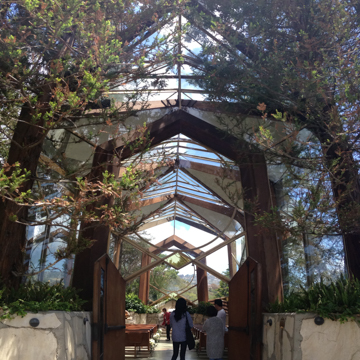The Wayfarers Chapel is a national memorial to Emanuel Swedenborg, founder of the Swedenborgian Church. The idea for the chapel, and its realization, was the work of two Swedenborgian women: Elizabeth Schellenberg, who envisioned a chapel on a hillside in the Palos Verdes Peninsula, and Narcissa Cox Vanderlip, who donated the land. Schellenberg intended the chapel to be used as a place for rest, contemplation, and meditation for those of any faith traveling along the Pacific Coast. The chapel was thus intended to express a belief in the harmony of God, the natural world, and the worshiper’s inner spiritual world. While Schellenberg and Vanderlip first discussed the project in the 1930s, the Depression and World War II postponed their plans until the late 1940s when they enlisted Lloyd Wright, son of the architect Frank Lloyd Wright. Lloyd Wright had an active practice in Southern California and his spiritual leanings aligned with the women’s vision. He began work on the project in 1949 and the chapel was largely completed by 1951, although work continued on a visitor’s center and a bell tower.
Wright, much like his father, believed buildings should demonstrate an organic relationship between structure and the natural world. For him, designing a structure in harmony with nature was also the best way to express the profound spiritual meaning befitting a place of worship. Location was thus a central part of the architectural parti: the chapel is sited on 3.5 acres above California’s scenic central coast. The ocean is not visible from the site, however, and at the time of construction the dusty hill was cleared of trees. Wright thus designed the “nature” to grow up around the building, conceiving in advance how the building would closely engage the landscape once it was fully developed.
Visitors approach the Wayfarers Chapel via a short walkway from a parking lot. The Chapel is slightly raised from the ground with a triangular arched double door entrance. Wright, demonstrating his exceptionally refined talent, organized the chapel into a series of equilateral arches to create a 30/60 degree triangulated structural geometry that defines the space. Inside, the chapel is largely transparent, with only a thin glass separation defining the space between interior and exterior. The glass enclosure sits on a stone base a few feet above the chapel’s stone floors and is ringed by a continuous planter that creates further connections between the foliage on both sides of the glass. The glazing is broken by harmonious geometrical patterns dominated by the large circles at the either end that represent the concept of spiritual inclusiveness. Six solid triangles on the ceiling serve as acoustical panels. A tower, part of the original design, was added in 1954. Wright used glass, redwood, and local Palos Verdes stone as the chapel’s primary materials, enabling the building to engage in a poetic and harmonic way with the foliage and the sky.
Wright’s inspiration for this “tree chapel” came from a recent trip he had taken to the redwood forests in Northern California. As he reimagined them for the Wayfarer sight, Wright’s approach to the landscape was patient. The architect planted redwood trees knowing it would take several decades for them to grow to the height he desired. Such patience has paid off and the landscape and the building are unified as planned. The plethora of glass enables nature to enter the chapel visually. The surrounding redwood trees serve as a kind of ornament and the building’s timber frames echo their trunks.
This was not Wright’s first engagement with landscape design. Born in 1890, he was a young boy in Oak Park, Illinois, while his father developed his idea of organic architecture in a series of Oak Park houses. During summers in Spring Green, Wisconsin, Wright was immersed in nature. Later, he joined the landscape design firm Olmsted and Olmsted, working first in Boston and later on the plantings for the 1915 Panama-Pacific International Exposition in San Diego. This brought him to Southern California, where he lived and worked for the rest of his life; his projects included overseeing the planting of Olive Hill on his father’s Hollyhock House (1922) in the Los Feliz neighborhood of Los Angeles. Wright continued his landscape design practice as part of his own architectural firm, which he founded in 1916.
The Chapel is backed by the Pacific Ocean but not far on the other side, hidden by a series of hills, is South Central Los Angeles and the rest of the city extending beyond. Here it sits as a respite from the urban extent of the greater Los Angeles area. Built with traveling visitors in mind, today the Chapel is also a popular location for weddings.
References
“History.” Wayfarers Chapel. Accessed July 16, 2018. http://www.wayfarerschapel.org/.
“Wayfarers Chapel.” Los Angeles Conservancy. Accessed July 16, 2018. https://www.laconservancy.org/.
Weintraub, Alan. Lloyd Wright: The Architecture of Frank Lloyd Wright Jr. New York: Abrams, 1998.

















